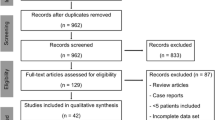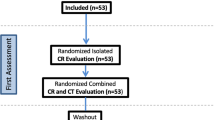Abstract
Background
Acute isolated syndesmotic injuries (AISIs) have a high potential to be misdiagnosed or underdiagnosed at initial presentation to the hospital. Although magnetic resonance imaging (MRI) is the gold standard in noninvasive diagnostics, it is not always available immediately and is much more expensive than other imaging modalities. This study identifies improvements in conventional radiography and computed tomography (CT) to diagnose AISI and aims to reduce the number of MRI scans needed to verify the diagnosis.
Methods
A retrospective case match control study was conducted by searching our trauma database between 2008 and 2022. A study group of patients with AISI (n = 64) and a control group of patients without AISI (n = 76) were formed to generate an equal number of images from both groups (62 radiographs and 22 CT scans). A total of 16 parameters that quantify the distal tibiofibular relation in injured and uninjured ankles were analyzed. For statistical analysis, a two-sided t-test was applied to calculate significant differences (p < 0.05). In a further step, a receiver operating characteristic curve (ROC) was used to determine cut-off values for the most significant parameters.
Results
The most significant measurement (p < 0.001) on axial CT scans was the syndesmotic area (SA). The ROC curve revealed an area under the curve (AUC) of 0.94 (95% CI 0.86–1.0) and a cut-off value of 71.68 mm2 that shows a sensitivity and specificity of 95.5% and 81.8%, respectively.
Conclusion
This study suggests that radiographic imaging could represent an equally accurate alternative to MRI. These methods might generate the correct diagnosis faster due to their availability and inexpensiveness. By applying our new cut-off values in a clinical setting, the number of underdiagnosed and untreated unstable syndesmotic injuries could be reduced.
Level of evidence
III, retrospective comparative study






Similar content being viewed by others
Data availability
The authors confirm that the data supporting the findings of this study are available within the article.
References
Abdelaziz ME, Hagemeijer N, Guss D, El-Hawary A, El-Mowafi H, DiGiovanni CW (2019) Evaluation of syndesmosis reduction on CT scan. Foot Ankle Int 40(9):1087–1093
Ahn TK, Choi SM, Kim JY, Lee WC (2017) Isolated Syndesmosis Diastasis: Computed Tomography Scan Assessment With Arthroscopic Correlation. Arthroscopy 33(4):828–834
Beumer A, van Hemert WL, Niesing R et al (2004) Radiographic measurement of the distal tibiofibular syndesmosis has limited use. Clin Orthop Relat Res 423:227–234
Boytim MJ, Fischer DA, Neumann L (1991) Syndesmotic ankle sprains. Am J Sports Med 19(3):294–298
Chen Y, Qiang M, Zhang K, Li H, Dai H (2015) A reliable radiographic measurement for evaluation of normal distal tibiofibular syndesmosis: a multi-detector computed tomography study in adults. J Foot Ankle Res 8:32
Del Rio A, Bewsher SM, Roshan-Zamir S et al (2020) Weightbearing cone-beam computed tomography of acute ankle syndesmosis injuries. J Foot Ankle Surg 59(2):258–263
Dikos GD, Heisler J, Choplin RH, Weber TG (2012) Normal tibiofibular relationships at the syndesmosis on axial CT imaging. J Orthop Trauma 26(7):433–438
Elgafy H, Semaan HB, Blessinger B, Wassef A, Ebraheim NA (2010) Computed tomography of normal distal tibiofibular syndesmosis. Skeletal Radiol 39(6):559–564
Futamura K, Baba T, Mogami A et al (2017) Malreduction of syndesmosis injury associated with malleolar ankle fracture can be avoided using Weber’s three indexes in the mortise view. Injury 48(4):954–959
Gardner MJ, Demetrakopoulos D, Briggs SM, Helfet DL, Lorich DG (2006) Malreduction of the tibiofibular syndesmosis in ankle fractures. Foot Ankle Int 27(10):788–792
Ginde AA, Foianini A, Renner DM, Valley M, Camargo CA Jr (2008) Availability and quality of computed tomography and magnetic resonance imaging equipment in U.S. emergency departments. Acad Emerg Med 15(8):780–783
Hagemeijer NC, Chang SH, Abdelaziz ME et al (2019) Range of normal and abnormal syndesmotic measurements using weightbearing CT. Foot Ankle Int 40(12):1430–1437
Han SH, Lee JW, Kim S, Suh JS, Choi YR (2007) Chronic tibiofibular syndesmosis injury: the diagnostic efficiency of magnetic resonance imaging and comparative analysis of operative treatment. Foot Ankle Int 28(3):336–342
Hermans JJ, Wentink N, Beumer A et al (2012) Correlation between radiological assessment of acute ankle fractures and syndesmotic injury on MRI. Skeletal Radiol 41(7):787–801
Hunt KJ, George E, Harris AH, Dragoo JL (2013) Epidemiology of syndesmosis injuries in intercollegiate football: incidence and risk factors from National Collegiate Athletic Association injury surveillance system data from 2004–2005 to 2008–2009. Clin J Sport Med 23(4):278–282
Kotwal R, Rath N, Paringe V, Hemmadi S, Thomas R, Lyons K (2016) Targeted computerised tomography scanning of the ankle syndesmosis with low dose radiation exposure. Skeletal Radiol 45(3):333–338
Krähenbühl N, Weinberg MW, Davidson NP et al (2018) Imaging in syndesmotic injury: a systematic literature review. Skeletal Radiol 47(5):631–648
Malhotra G, Cameron J, Toolan BC (2014) Diagnosing chronic diastasis of the syndesmosis: a novel measurement using computed tomography. Foot Ankle Int 35(5):483–488
Malhotra K, Welck M, Cullen N, Singh D, Goldberg AJ (2019) The effects of weight bearing on the distal tibiofibular syndesmosis: a study comparing weight bearing-CT with conventional CT. Foot Ankle Surg 25(4):511–516
Nault ML, Hébert-Davies J, Laflamme GY, Leduc S (2013) CT scan assessment of the syndesmosis: a new reproducible method. J Orthop Trauma 27(11):638–641
Oae K, Takao M, Naito K et al (2003) Injury of the tibiofibular syndesmosis: value of MR imaging for diagnosis. Radiology 227(1):155–161
Patel S, Malhotra K, Cullen NP, Singh D, Goldberg AJ, Welck MJ (2019) Defining reference values for the normal tibiofibular syndesmosis in adults using weight-bearing CT. Bone Jt J 101-b(3):348–352
Ryan LP, Hills MC, Chang J, Wilson CD (2014) The lambda sign: a new radiographic indicator of latent syndesmosis instability. Foot Ankle Int 35(9):903–908
Schoennagel BP, Karul M, Avanesov M et al (2014) Isolated syndesmotic injury in acute ankle trauma: comparison of plain film radiography with 3T MRI. Eur J Radiol 83(10):1856–1861
Scranton PE Jr, McMaster JG, Kelly E (1976) Dynamic fibular function: a new concept. Clin Orthop Relat Res 118:76–81
Shakoor D, Osgood GM, Brehler M et al (2019) Cone-beam CT measurements of distal tibio-fibular syndesmosis in asymptomatic uninjured ankles: does weight-bearing matter? Skeletal Radiol 48(4):583–594
Souleiman F, Heilemann M, Hennings R et al (2022) Effect of weightbearing and foot positioning on 3D distal tibiofibular joint parameters. Sci Rep 12(1):9357
Takao M, Ochi M, Oae K, Naito K, Uchio Y (2003) Diagnosis of a tear of the tibiofibular syndesmosis. The role of arthroscopy of the ankle. J Bone Jt Surg Br 85(3):324–329
van den Bekerom MP (2011) Diagnosing syndesmotic instability in ankle fractures. World J Orthop 2(7):51–56
van den Bekerom MP, de Leeuw PA, van Dijk CN (2009) Delayed operative treatment of syndesmotic instability. Current concepts review Injury 40(11):1137–1142
Yeung TW, Chan CY, Chan WC, Yeung YN, Yuen MK (2015) Can pre-operative axial CT imaging predict syndesmosis instability in patients sustaining ankle fractures? Seven years’ experience in a tertiary trauma center. Skeletal Radiol 44(6):823–829
Zamzami MM, Zamzam MM (2009) Chronic isolated distal tibiofibular syndesmotic disruption: diagnosis and management. Foot Ankle Surg 15(1):14–19
Funding
None.
Author information
Authors and Affiliations
Contributions
HCB, AK, and MD designed the study. HCB, AK, AK, and MD performed the research. HCB, AK, and JTV provided help and advice on the search and interpretation. AK analyzed the data. HCB, AK, AK, MD, and JTV were involved in writing the manuscript. All authors read and approved the final manuscript.
Corresponding author
Ethics declarations
Conflict of interest
The authors declare that they do not have any conflict of interest.
Ethical approval
The Charite Berlin University hospital ethical committee approved the study EA1/283/21.
Informed consent
As this study is of retrospective design, no informed consent was required.
Additional information
Publisher's Note
Springer Nature remains neutral with regard to jurisdictional claims in published maps and institutional affiliations.
Rights and permissions
Springer Nature or its licensor (e.g. a society or other partner) holds exclusive rights to this article under a publishing agreement with the author(s) or other rightsholder(s); author self-archiving of the accepted manuscript version of this article is solely governed by the terms of such publishing agreement and applicable law.
About this article
Cite this article
Kunde, A.M.H., Vosseller, J.T., Dahne, M. et al. Combining radiographic and CT measurements to rival MRI for the diagnosis of acute isolated syndesmotic injury. Arch Orthop Trauma Surg 143, 6631–6639 (2023). https://doi.org/10.1007/s00402-023-04985-w
Received:
Accepted:
Published:
Issue Date:
DOI: https://doi.org/10.1007/s00402-023-04985-w




